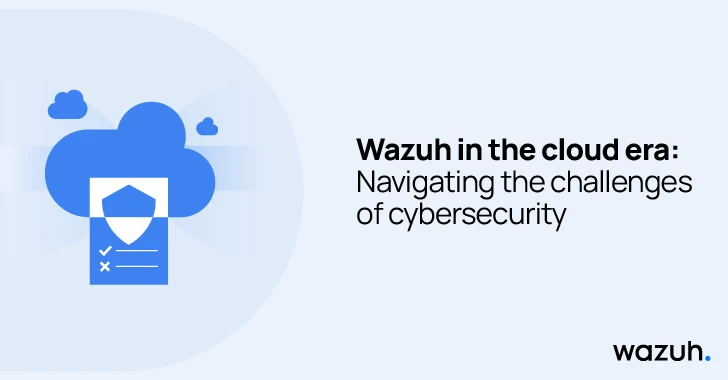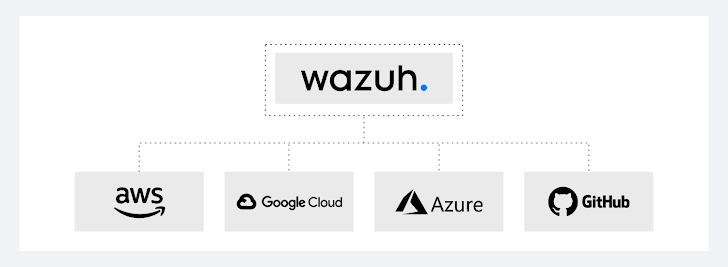Cloud computing has innovated how organizations operate and manage IT operations, such as data storage, application deployment, networking, and overall resource management. The cloud offers scalability, adaptability, and accessibility, enabling businesses to achieve sustainable growth. However, adopting cloud technologies into your infrastructure presents various cybersecurity risks and challenges that demand diligent consideration. In this blog post, we will explore some challenges of cybersecurity in the cloud era. We will also delve into how Wazuh, a cybersecurity solution supporting cloud platforms like Amazon Web Services (AWS), Microsoft Azure, Github, and Google Cloud Platform (GCP), can help address these challenges effectively.
The rise of cloud computing
Cloud computing deploys services, including servers, storage, software, databases, networking, and intelligence over the Internet "the cloud" to offer flexible resources, faster innovation, and cost efficiencies. Cloud computing has witnessed rapid adoption across industries, revolutionizing how businesses operate and store their data. With cloud services, organizations can leverage the scalability and flexibility offered by cloud providers, eliminating the need for extensive on-premises infrastructure. This shift to the cloud allows businesses to concentrate on their main objectives and foster innovation.
Challenges of cloud computing
While cloud computing offers numerous benefits, such as cost savings, increased efficiency, and seamless collaboration, it also introduces unique cybersecurity challenges. Addressing these challenges is paramount for organizations venturing into cloud environments.
Data privacy and compliance: A major challenge in the cloud era revolves around ensuring data privacy and compliance with regulations. With data stored and processed in various cloud environments, organizations must ensure compliance with regulations such as GDPR, HIPAA, and others. Failure to comply with these regulations can result in severe consequences, including fines and reputational damage. Shared responsibility model: Another critical aspect is the shared responsibility model inherent in cloud computing. This model in cloud computing means that cloud service providers are responsible for securing the underlying infrastructure, while businesses are responsible for securing their data and applications. While cloud providers can also handle business data and applications, organizations must still possess a comprehensive understanding of their responsibilities, implementing security measures to safeguard their assets. Multi-cloud environments: Embracing multi-cloud environments introduces new challenges from the integration and interoperability between different cloud providers. These challenges include complexities from managing multiple configurations and access controls, security patching gaps, navigating diverse regulatory frameworks, and inconsistent security visibility across multiple platforms. This challenge requires a focused approach to address varied security needs within the multi-cloud landscape. Expanded attack surface: As IT resources extend across multiple cloud and on-premises environments, the risk and potential of cyberattacks increase significantly. The obligation to secure virtual servers, remote applications, containers, and network interactions between environments accompanies the presence in the cloud.In addition to the challenges discussed, organizations must address other challenges like lack of knowledge and expertise, reliability and availability, cost management, and password security. Each of these challenges requires careful consideration and strategic planning to ensure a resilient and secure cloud infrastructure.
The role of Wazuh in cloud security
Wazuh is an open source cybersecurity platform that offers unified XDR and SIEM capabilities to improve security for on-premises endpoints and cloud workloads. It provides monitoring, detection, and alerting of security events and incidents within your environment. Wazuh helps organizations secure their cloud infrastructure effectively and protect against emerging cybersecurity threats with its capabilities and flexible architecture.
Wazuh is adaptable to the dynamic nature of cloud environments. Whether organizations use public, private, or hybrid clouds, Wazuh can integrate with their infrastructure, providing real-time threat detection and incident response capabilities. Wazuh protects cloud workloads on platforms like Amazon Web Services (AWS), Microsoft Azure, Github, and Google Cloud.
Wazuh cloud security capabilities
Wazuh offers a range of capabilities tailored to enhance cloud security.
Comprehensive log management: Wazuh offers extensive log management capabilities, allowing organizations to collect, analyze, and store logs from various cloud platforms and applications. By centralizing log data, Wazuh provides valuable insights into potential security incidents and helps organizations meet compliance requirements. These logs that can be collected from both monitoring cloud instances and services are managed and tailored to the cloud platform in scope. Real-time threat detection and incident response: Wazuh can detect threats in real-time. With its monitoring capabilities, Wazuh provides visibility into your cloud environments, allowing you to monitor and detect suspicious activities and security incidents, and respond promptly and mitigate potential risks. Vulnerability management: Wazuh streamlines the process of detecting vulnerabilities by automating the identification of potential risks. This aids security teams in efficiently addressing critical security concerns. Automated vulnerability management significantly diminishes the cloud environment's attack surface, enhancing the overall security stance. Compliance management: Wazuh audits your cloud infrastructure to ensure regulatory compliance. It offers out-of-the-box rulesets and templates that facilitate compliance checks. Wazuh systematically examines monitored endpoints, verifying adherence to PCI-DSS, HIPAA, NIST, TSC, CIS, and other applicable regulations. Furthermore, the Wazuh Security Compliance Auditing (SCA) module empowers system administrators to validate alignment with internal policies and standards. File integrity monitoring: Ensuring file integrity is important when safeguarding sensitive data in diverse cloud environments. The Wazuh FIM module offers continuous monitoring, alerting in real-time unauthorized changes to sensitive files and directories. This is vital for preserving data privacy and preventing unauthorized access. Scalability: As businesses scale their cloud infrastructure, Wazuh can scale with them. Wazuh architecture allows for scalability by adding more nodes of Wazuh central components to the existing infrastructure. This ensures organizations can monitor and protect their expanding cloud environments without compromising performance.Conclusion
Cybersecurity is paramount in this cloud era, where the digital landscape is ever-evolving. As organizations embrace the benefits of cloud computing, they must also address the challenges associated with securing their cloud environments. Wazuh provides an effective solution for navigating the complexities of cybersecurity in the cloud era with its capabilities and flexibility. By using Wazuh, organizations can enhance their security posture, detect real-time threats, and protect their valuable data and applications.
Wazuh is an open source unified XDR and SIEM platform that monitors endpoints, cloud services, and containers. It offers flexibility in integrating with various cloud solution providers, including Amazon Web Services, Microsoft Azure, and Google Cloud, while delivering comprehensive visibility and robust security capabilities.
Found this article interesting? Follow us on Twitter and LinkedIn to read more exclusive content we post.
.png)
 9 months ago
80
9 months ago
80 

















 Bengali (Bangladesh) ·
Bengali (Bangladesh) ·  English (United States) ·
English (United States) ·